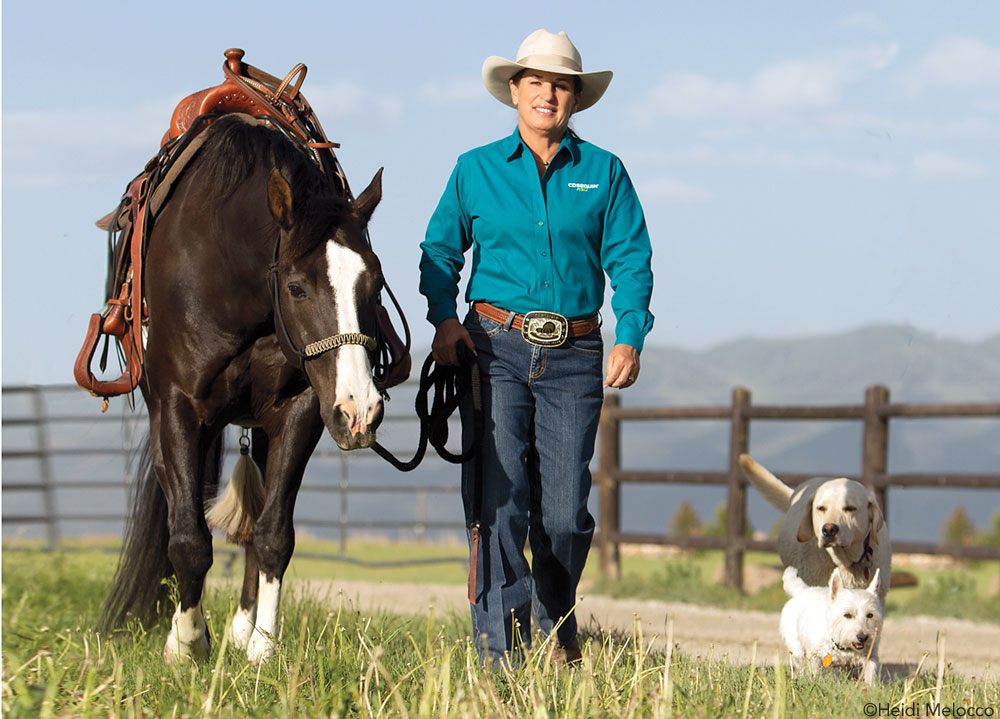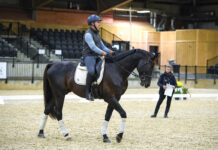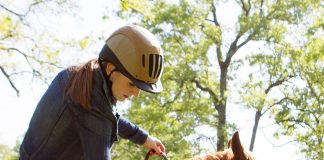If you get too comfortable around a horse, even one that you have a great relationship with, you may put yourself in an unsafe zone. The result? What I like to call “Stupid Human Tricks.” These are the moves and resulting injuries that could end up on “America’s Funniest Home Videos,” but really didn’t need to happen at all.

If you operate with awareness and safety in mind, you’re less likely to be hurt. Keep in mind that there’s no such thing as a horse without a flight response. There are things you have no control over that may spook your horse.
Have you ever had the voice of your conscience in your head asking, “Should I do this?” If so, you probably shouldn’t. It only takes a few added seconds to do things the right way—and if you choose the safe way, you’ll have a better and longer relationship with your best buddy.
I’m not naïve enough to think that you will never again do anything on this list. However, it’s important to know that these moves are risky. It’s up to you to know the possibilities and choose how much risk to take. Here are my top “Stupid Human Tricks” and details about why you really shouldn’t perform them.
Ducking Under
Don’t duck under a lead rope when a horse is tied, and never lead another horse under the cross-ties beside a horse that’s tied. If you duck under the horse and he spooks or pulls back, it’s easy to get trapped between your horse and a wall. Why do we do it? It’s just an instance of being lazy. You’re in his blind spot when you are under his neck. Even a horse who usually minds his step might not know where you are. Plus, if the horse is tied loosely, he could drop his head quickly and hit you when he moves. You don’t want to be so close to a horse’s head while in a compromising position.
Not Taking Time to Halter
Just because your horse will stand still while you put on or take off a blanket without a halter or lead rope, it doesn’t mean that it’s safe to do. If the horse is startled while you’re in the middle of your task, you have no way to control him. What happens? He gets caught up in the blanket, tears the blanket, or just learns that he can get away whenever he wants to.
If what you’re doing could be remotely objectionable to the horse, he may learn that he can run away when he wants. That is a hard lesson to un-learn. Personally, I’d rather be riding and doing fun things with my horses instead of working through a behavior issue that I caused. Take the extra time to confine your horse with a halter before you pick his feet, put on or take off a blanket or start working with him.
Sitting or Kneeling
It’s easy to put a knee down when bandaging, or to take a seat on the ground when you’re just hanging out with your horse. Don’t do it.
This one is near to my heart. When I was 14, my friend sat down in the pasture after our ride—just to watch the horses eat. My horse came up and tried to take the grain away from hers. The horses picked a fight and she was in the way—and sitting with her legs crisscrossed. She couldn’t get out of the way in time and was kicked in the abdomen. She bled to death.
There is a tried and true rule that you should be at least two horse lengths away from a horse before putting a knee down. The average horse is 8 feet long, so that means no sitting within 16 feet. It’s all about how fast you can get up. If you can’t get to your feet, you can’t get out of the way. It’s just a lazy move and it’s not worth it.
Leading by the Halter
If you’re leading a horse with a halter on, there should be a lead rope attached. A horse can toss his head quickly—think of how quickly he can reach back to bite at a fly. If your hand is in the halter and he shakes his head, you may not have time to let go and you’ll injure your fingers.
Your arm is up and in an awkward position when you grab a tall horse’s halter; it’s easy to dislocate a shoulder or get pulled on and cause a severe shoulder injury. Worse, your arm could be pushed through the halter and then you’ll be attached to a horse that will likely spook at having you move with him.
People lose fingers when the strap or dee-ring on the halter suddenly is tight (as a related safety note, when you do use a lead line, make sure that it never wraps around your hand). Plus, if you let go of the horse when he jerks away, you have no way to confine him and you’ll teach the horse that it’s easy to pull away from you. This move can mean losing a digit or facing a long re-training session for your horse.
Dropping the Reins
Single loop rope reins may not break if the horse steps on them. You should never allow your rope reins to hang down from your horse’s bridle. If you’re saddling up, lay the reins over your arm. If you’re planning to ground tie in the middle of a ride, leave the loop reins over your horse’s neck; use a halter and lead if you need a line on the ground. You can ground tie your horse in split reins with the reins hanging down, but never with loop reins. If the horse steps through the loop, he’ll get tangled and hurt his mouth. You’ll probably also break your bridle. With a loop rein, keep the reins over your horse’s head and secure around the saddle horn (in a western saddle) or through a stirrup leather (in an English saddle).
How many of these stupid human tricks have you done in the past? Now that you know the risks, take a moment and do things the right way. You’ll spare yourself and your horse pain and you’ll be ready to go have fun!
More from Julie Goodnight:
Fear Management
Good Horse, Bad Horse
This article originally appeared in the August 2015 issue of Horse Illustrated magazine. Click here to subscribe!







Thanks for the reminders! It is easy to become complacent. I try to think of my horse the way I think of my power saw: one second of inattention or carelessness can lead to a world of woe!
Excellent read. Thank you for the reminders. We all get a little sloppy and lazy with and around horses.
Good Advice. I do two of these things. I am not a seasoned rider but I KNOW these things now and I on occasion doing them. Ducking under the tied lead. Sitting in the pasture with them. Thank you for the info. Good reminder
Never stick your head under a horses belly. A friend was working on a front leg and trusted her old tried and true horse when she shouldn’t .
I was leading my horse to the field one morning as I did every day and ended up with a dislocated hip and to this day, have no idea what happened or what spooked him! I just remember flying through the air and landing with my leg detaching from my body.
I was leading my horse to the field one morning as I did every day and ended up with a dislocated hip and to this day, have no idea what happened or what spooked him! I just remember flying through the air and landing with my leg detaching from my body.
??
It really bothers me when I see respected clinicians do unsafe things like wrap a lead around their hand or arm or let a lead drag on the ground and wrap around their legs. Setting a very poor example.
Excellent advice. As a former CHA instructor I made sure my students didn’t do any of these things (in my presence anyway) but your article made clear the reasons why they shouldn’t do them. Thanks, Julie!
Funny but thinking back I’ve done all of these. Just takes a second, not thinking, running late, or even just trusting the horse they never mean to but accidents happen.
I remember reading an article where a trainer died because she was leading her horse(s) to or from pasture and put the lead rope over her shoulder. The horse spooked, it got wrapped around her neck and she was dragged/choked to death.
I know a woman who didn’t use a lead rope one time and she absentmindedly let two fingers slip inside the metal ring on the halter. The horse spooked (tall Saddlebred horse) and those two fingers got dislocated and actually had to be amputated!
I was in a clinic several years ago with a world known clinician and one of the first things she said at the beginning was “it’s the calm horse that will kill you”. I have never forgotten that. We become very careless around horses that we know well and are considered “bomb proof”, until they aren’t.